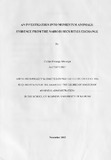| dc.contributor.author | Mwungu, Collins M | |
| dc.date.accessioned | 2013-03-01T06:51:28Z | |
| dc.date.issued | 2012-11 | |
| dc.identifier.citation | MBA Thesis 2012 | en |
| dc.identifier.uri | http://erepository.uonbi.ac.ke:8080/xmlui/handle/123456789/12790 | |
| dc.description | Master Thesis | en |
| dc.description.abstract | This study set out to investigate further evidence on momentum anomaly at the NSE. Part
of the study involved decomposing momentum profits based on firm size and testing for
the influence of FF three-factor model.
At the beginning of each month t the stocks are ranked in ascending order based on their
cumulated returns over the previous J months where J is 3, 6, 9 or 12. Based on the
rankings, the stocks are assigned to one of three terciles. The portfolios are then held for
the next K months, where K is 3, 6, 9 or 12. t-statistics are then used to test the
hypothesis.
The six month formation strategy outperforms all other strategies irrespective of the
holding period. All the zero cost strategies yield positive returns which are statistically
significant except the 12-month/12-month strategy. The best performing strategy is the 6month/3-month
which gives an average monthly return of 1.62 %.
The 6-month/6-month strategy is used to decompose momentum profits based on firm
size. The smallest firms generate the lowest abnormal returns, while the largest firms
generate lower abnormal returns compared to medium firms. Time series regressions
show that the FF three-factor model does not influence momentum profits. | en |
| dc.description.sponsorship | University of Nairobi | en |
| dc.language.iso | en | en |
| dc.publisher | University of Nairobi, | |
| dc.subject | Stocks,Profit,Firm | en |
| dc.title | An Investigation Into Momentum Anomaly: | en |
| dc.title.alternative | Evidence from the Nairobi Securities Exchange | en |
| dc.type | Thesis | en |
| local.embargo.terms | 6 months | en |
| local.publisher | School of Business, University of Nairobi | en |

